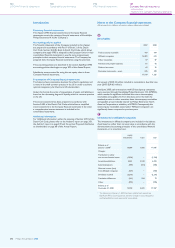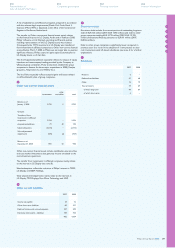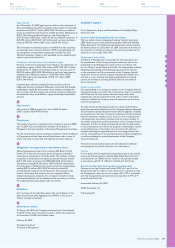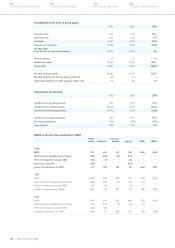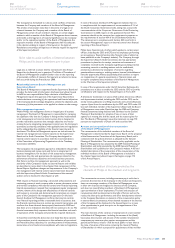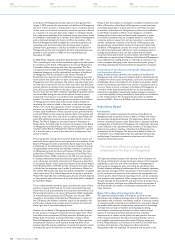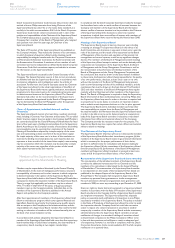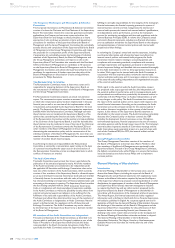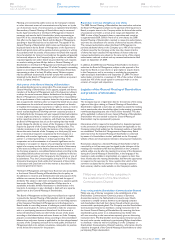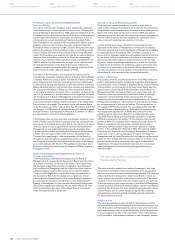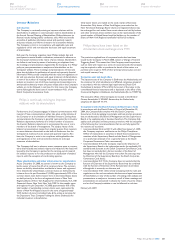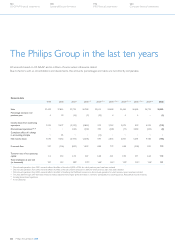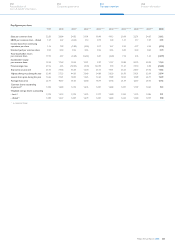Philips 2008 Annual Report Download - page 255
Download and view the complete annual report
Please find page 255 of the 2008 Philips annual report below. You can navigate through the pages in the report by either clicking on the pages listed below, or by using the keyword search tool below to find specific information within the annual report.
The Company has formalized its rules to avoid conflicts of interests
between the Company and members of the Board of Management.
The articles of association state that in the event of a legal act or
a lawsuit between the Company and a member of the Board of
Management, certain of such member’s relatives, or certain (legal)
entities in which a member of the Board of Management has an interest,
and insofar as the legal act is of material significance to the Company
and/or to the respective member of the Board of Management, the
respective member of the Board of Management shall not take part
in the decision-making in respect of the lawsuit or the legal act.
Resolutions concerning such legal acts or lawsuits require the approval
of the Supervisory Board.
Strict rules to avoid conflicts of interest between
Philips and its board members are in place
Legal acts as referred to above shall be mentioned in the Annual
Report for the financial year in question. The Rules of Procedure of
the Board of Management establish further rules on the reporting
of (potential) conflicts of interests. No legal acts as referred to above
have occurred during the financial year 2008.
Relationship between Board of Management and
Supervisory Board
The Board of Management is supervised by the Supervisory Board and
provides the latter with all information the Supervisory Board needs
to fulfill its own responsibilities. Major decisions of the Board of
Management require the approval of the Supervisory Board; these
include decisions concerning (a) the operational and financial objectives
of the Company, (b) the strategy designed to achieve the objectives, and,
if necessary, (c) the parameters to be applied in relation to the strategy.
Risk management approach
Within Philips, risk management forms an integral part of business
management. The Board of Management is responsible for managing
the significant risks that the Company is facing and has implemented
a risk management and internal control system that is designed to
provide reasonable assurance that strategic objectives are met by
creating focus, by integrating management control over the Company’s
operations, by ensuring compliance with applicable laws and regulations
and by safeguarding the reliability of the financial reporting and its
disclosures. The Board of Management reports on and accounts for
internal risk management and control systems to the Supervisory
Board and its Audit Committee. The Company has designed its
internal control system in accordance with the recommendations
of the Committee of Sponsoring Organizations of the Treadway
Commission (COSO).
The Company’s risk management approach is embedded in the periodic
business planning and review cycle and forms an integral part of
business management. On the basis of risk assessments, management
determines the risks and appropriate risk responses related to the
achievement of business objectives and critical business processes.
Risk factors and the risk management approach as well as the
sensitivity of the Company's results to external factors and variables
are described in more detail in the chapter Risk management of this
Annual Report. Significant changes and improvements in the Company’s
risk management and internal control system have been discussed
with the Supervisory Board’s Audit Committee and the external
auditor and are disclosed in that chapter as well.
With respect to financial reporting a structured self-assessment and
monitoring process is used company-wide to assess, document, review
and monitor compliance with internal control over financial reporting.
Internal representations received from management, regular management
reviews, reviews of the design and effectiveness of internal controls
and reviews in corporate and divisional audit committees are integral
parts of the Company’s risk management approach. On the basis
thereof, the Board of Management confirms that internal controls
over financial reporting provide a reasonable level of assurance that
the financial reporting does not contain any material inaccuracies, and
confirms that these controls have properly functioned in 2008 and
that there are no indications that they will not continue to do so. The
financial statements fairly represent the financial condition and result
of operations of the Company and provide the required disclosures.
It should be noted that the above does not imply that these systems
and procedures provide certainty as to the realization of operational
and financial business objectives, nor can they prevent all misstatements,
inaccuracies, errors, fraud and noncompliances with rules and regulations.
In view of the above the Board of Management believes that it is
in compliance with the requirements of recommendation II.1.4. of
the Dutch Corporate Governance Code, taking into account the
recommendation of the Corporate Governance Code Monitoring
Committee in its 2005-report on the application thereof. This
statement should not be construed as a statement in response to
the requirements of section 404 of the US Sarbanes-Oxley Act.
The statement as to compliance with Section 404 is set forth in
the section Management's report on internal control over financial
reporting of this Annual Report.
Philips has a financial code of ethics which applies to certain senior
officers, including the CEO and CFO, and to employees performing
an accounting or financial function (the financial code of ethics has
been published on the Company’s website). The Company, through
the Supervisory Board’s Audit Committee, also has appropriate
procedures in place for the receipt, retention and treatment of
complaints received by the Company regarding accounting, internal
accounting controls or auditing matters and the confidential,
anonymous submission by employees of concerns regarding
questionable accounting or auditing matters. Internal ‘whistleblowers’
have the opportunity, without jeopardizing their position, to report
on irregularities of a general, operational or financial nature and
to report complaints about members of the Board of Management
to the Chairman of the Supervisory Board.
In view of the requirements under the US Securities Exchange Act,
procedures are in place to enable the CEO and the CFO to provide
certifications with respect to the Annual Report on Form 20-F.
A Disclosure Committee is in place, which advises the various officers
and departments involved, including the CEO and the CFO, on the
timely review, publication and filing of periodic and current (financial)
reports. Apart from the certification by the CEO and CFO under US
law, each individual member of the Supervisory Board and the Board
of Management must under Dutch law, sign the IFRS and Company
financial statements being disclosed and submitted to the General
Meeting of Shareholders for adoption. If one or more of their
signatures is missing, this shall be stated, and the reasons given for
this. The Board of Management issues the statement on page 192
pursuant to requirements of Dutch civil and securities laws.
Amount and composition of the remuneration
of the Board of Management
The remuneration of the individual members of the Board of
Management is determined by the Supervisory Board on the proposal
of the Remuneration Committee of the Supervisory Board, and is
consistent with the policies thereon as adopted by the General
Meeting of Shareholders. The remuneration policy applicable to the
Board of Management was adopted by the 2004 General Meeting of
Shareholders, and lastly amended by the 2008 General Meeting of
Shareholders and is published on the Company’s website. A full and
detailed description of the composition of the remuneration of the
individual members of the Board of Management is included in
the chapter Supervisory Board report that begins on page 114
of this Annual Report.
The remuneration structure promotes the
interests of Philips in the medium and long-term
The remuneration structure, including severance pay, is such that it
promotes the interests of the Company in the medium and long-term,
does not encourage members of the Board of Management to act
in their own interests and neglect the interests of the Company,
and does not reward failing members of the Board of Management
upon termination of their employment. The level and structure of
remuneration shall be determined in the light of factors such as the
results, the share price performance and other developments relevant
to the Company. Deviations on elements of the remuneration policy
in extraordinary circumstances, when deemed necessary in the interest
of the Company, will be disclosed in the Annual Report or, in case
of an appointment, in good time prior to the appointment of the
person concerned.
The main elements of the contract of employment of a new member
of the Board of Management - including the amount of the (fixed)
base salary, the structure and amount of the variable remuneration
component, any severance plan, pension arrangements and the
general performance criteria - shall be made public no later than at
the time of issuance of the notice convening the General Meeting
of Shareholders in which a proposal for appointment of that member
Philips Annual Report 2008 255
254
Corporate governance
250
Reconciliation of
non-US GAAP information
262
Ten-year overview
266
Investor information



